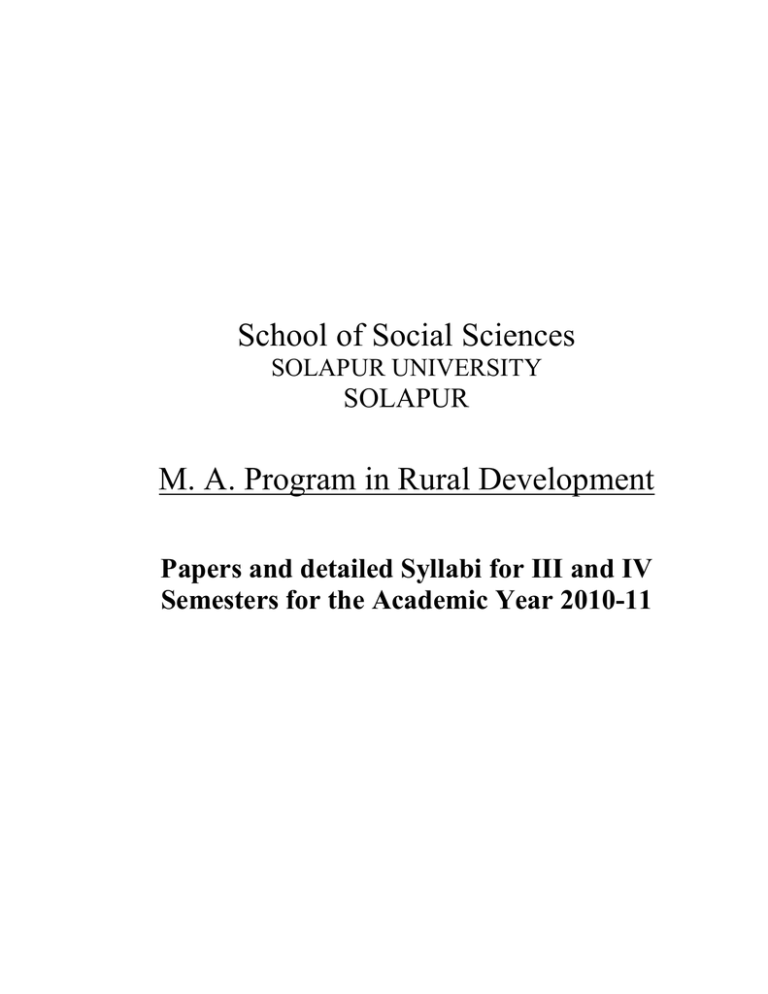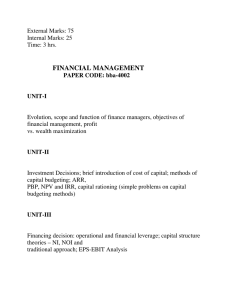School of Social Sciences M. A. Program in Rural Development SOLAPUR
advertisement

School of Social Sciences SOLAPUR UNIVERSITY SOLAPUR M. A. Program in Rural Development Papers and detailed Syllabi for III and IV Semesters for the Academic Year 2010-11 Semester 3: List of papers Paper IX: Dimensions of Development Communication Paper X: Human Development: Concepts and Measurements Paper XI: Research Methods in Social Sciences Paper XII: Application of Computers in Social Sciences Semester 4: List of papers Paper XIII: Sustainable Rural Livelihoods Paper XIV: Rural Non-Farm Sector and Entrepreneurship Paper XV: Land Management for Rural Development Paper XVI: Dissertation Paper IX: Dimensions of Development Communication Unit-I Development: concept & meaning, social change, modernization & development, characteristics of developed &, developing societies. Models of development- Western, Eastern, Gandhian, Schmachars, Development communication – concept & meaning. Unit-II. Social & economic issues in development- Population control, national integration, women & child development, upliftment of weaker sections, education & literacy, poverty, unemployment, human rights, environment, health, hygiene & nutrition. Concept of sustainable development and its dimensions, sustainability of natural resources and other issues. Unit-III. Role of various sectors in development, government sector, public sector, corporate sector, NGOS, national & international bodies, media used for development communication. Unit-IV. Agricultural communication and rural development:- concept & importance models of agricultural extension, extension, case studies of communication support to agriculture. Panchayat Raj: planning at national, state, regional, district & village levels, rural journalism, electronic media and agriculture development programmer, role of radio in agricultural development, folk media & development. Unit-V. Writing development massages for rural audience: specific requirements of media writing with special reference to radio and television, rural journalism and communication tools and techniques. References: Uma Narula, Development Communication –Haranand Pullication, New Delhi. Dua & Gupta, Media & Development - Haranand Publication, New Delhi. Uma Joshi- Understanding Development Communication – Dominant Publication & Distributors, New Delhi. Jan Servaes - Communication for Development & Social Change Sage Publication, New Delhi. Subhash Bhatnagar & Robart Schware – Information & Communication Tech in Development. Sage Publication, New Delhi. Avik Ghosh – Communication Technology & Human Development. Sage Publication, New Delhi. Shrinivas Melkote/ H - Leslie Steeves - Communication for Development In Third world, Sage Publication, New Delhi. Bella Modi- Designing Messages for Development Communication. Sage Publication, New Delhi. Anastasia Nilopoulou, Tisha Abralam, Farid Mirbagheeri –Cultivating Development. Sage Publication, New Delhi. Paper X: Human Development: Concepts and Measurements Unit I: Human Development: Meaning and Approach; Critic of Growth Oriented Theories; Evolution of Human Development Issues and Reports; Human Development Measures and Indicators/indices. Unit II: Role of the State in Human Development: Poverty Alleviation Programs; Promotion of Health Needs; Expansion of Education; and Livelihood Security. Unit III: Financing Human Development: Public Expenditure on Human Development across various states; Analytical Framework for Financing; Strengthening Resources at Panchayat level; and Financing Health care services. Unit IV: Planning for Human Development: Preparation of District Plans from Below; Process and Peoples Participation; Mapping of Activities among PRIs for Human Development. Unit V: Gender Budgeting: Introduction to Gender and Related Issues; Gender Budgeting; Some case studies of Gender Budgeting. List of References and Websites: Gadgil, D.R. 1967. District Development Planning. Gokhale Institute of Politics and Economics: Poona. Government of Maharashtra, (2002) Human Development Report. Haq, Mahbub Ul 1998. Reflections on Human Development. Oxford University Press, New Delhi. Human Development Report 1990. Oxford University Press, New Delhi. Human Development Report 2004. Oxford University Press, New Delhi. Seth, Mira 2001. Women and Development: Indian Experience. Sage, New Delhi. Singh, Radha Raman 1982. Studies in Regional Planning and Rural Development. Associated Book Agency: Patna. Singh, Tarlok 1969. Towards an Integrated Society: Reflections on Planning, Social Policy and Rural Institutions. Orient Longman: Bombay. Tim Allen and Alan Thomas (eds) 1990. Poverty and Development. Oxford University Press, Oxford. www.undp.org Paper XI: Research Methods in Social Sciences Unit I: Philosophical Roots and Significance of Social Research: Meaning and History of Social science Research; Philosophical Roots; Positivism, Hermeneutics, and interpretative Traditions. Importance of Social Research: Knowledge Economy and Knowledge Society; Research as an Empowering Profession; Research temperament and qualities of a good researcher. Unit II: Research Process and Design: Finding and Formulating Research Topic; Use of Concepts, Variables, and Hypotheses; Setting Research Objectives / Questions, Reviewing Relevant Literature. Research Design: Meaning and Types of Research Designs; Descriptive, Analytical, Explorative, Basic and Applied Research Designs; Unit III: Techniques of Sampling and Data Collection: Meaning and Types of Sampling; Random, Stratified, Quota, Systematic, Cluster and Judgment Sampling Procedures. Collection of Primary Data: Questionnaires, Interview Schedules, Observation Method, Case Studies, Content Analysis and Survey Methods. Collection of Secondary Data: Historical Documents, Archival Material, Published Sources, Journals, Internet Sources, Census, NSS and Statistical Reports. Unit IV: Analysis of Data and Use of Statistics: Meaning of Data Analysis; Classification and Tabulation of Data. Application of Statistics: Proportions and percentages, Measures of Central Tendency (mean mode and median); Measures of Dispersion (Range, Standard Deviation and Coefficient of Variation). Unit V: Writing Research Proposal and Report: Some Practical Tips. References: Baily K.D, 1982, Mothods of Social Research Free press, New York. Bajpai S.R. 1969. Social Survey and Research. Kanpur: Kitab Ghar. Barnes,John A, 1979,Who Should Know What ? Social Science, Privacy and Ethics, Harmondsworth, Penguin. Bleicher M. 1988.The Hermeneutic Inagination, London. Routlcdege and Kegan Paul (Introduction onlu) Bose.Pradip Kumar,1995: Research Methodology, New Delhi,ICSSR. Bryman, Alan,1988, Quality and Quantity in Social Research, London: Unwin Hyman. Fayerabad,Paul,1975, Against Method: Outline of an Anarchistic Theory of Knowledge, London, Humanities Press. Goode, J. and Hatt P.J., Mcthods in Social Research,New York McGraw Hill. Gupta S.P. 1984, Statistical Methods, New Dehil: Sulthan Chand and Sons. Hawthorno, Geoffroy, 1976, Enlightment and Dospair, A History of Sociology, Cambridge, Cambridge University. Hughes, Jon, 1987, The Philosophy of Social Research, London, Longmon. Indian Journal of Social work 1985, Spccial issue of Research Mothodology Irvine. J.I. Miles and J. Evans ( eds) 1979. Demystifying Social Statistics. London, Pluto Press. Mukherjce, P.N. (eds),2000, Methodology in Social Research. Delimmas and perspectives, New Delhi, Sage ( Introduction). Popper K., 1999, The Logic of Scientific Discovery, London, Routledge. Puch, Keith, 1986, The Introduction to Social Research,London,Sage. Srinivas, M.N. And A.M Shah 1979, Field Worker and the Filed, New Delhi.Oxford. Young Papuline V. 1946. Scientific, Social Survey and Research. New York. Prentice Hall. Paper-XII: COMPUTER APPLICATIONS IN SOCIAL SCIENCE Unit-1. Introduction to Computer System, Input and Output Devices: (a) Basic components of computer – CPU, Hardware and Software, (b) Input Devices, Output Devices, Secondary Storage Devices, (c) Operating System and Internet Unit-2. Application of Software: (a) Microsoft Excel: Excel Main menu, Worksheet structure, columns, , Excel Commands, Data Analysis. rows and (b) SPSS: Data Entry, Define variable, Frequency Distribution, Cross tabulation, Descriptive Statistics, Correlation Analysis, Linear Regression . Unit-3. Descriptive Statistics, Correlation and Regression: (a) Measures of Central Tendency: Arithmetic Mean, Geometric Mean and Harmonic Mean (b) Dispersion Analysis: Range, Quartile Deviation, Mean Deviation, Standard Deviation and Coefficient of Variation Correlation Analysis: (i) Karl Pearson’s Coefficient of Correlation (ii) Spearman’s Rank Coefficient of Correlation. (c) (d) Median, Mode, Regression Analysis: Types of regression, Two lines of Regression Equations, Multiple Regression Analysis. Unit-4. Time Series Analysis, Growth Rates and Graphical Presentation: (a) Time Series Analysis: measurement of trend: Free hand / Graphic Method, Semi-Average Method, Moving – Average Method, and Method of Least Square-fitting a straight line trend. (b) Growth Rates: Simple Growth Rate, Compound Growth Rate (c) Diagrammatic Presentation of Data : (i) Line Graph, (ii) Bar Diagram, (iii) Pie Chart, (iv) Histogram (v) Frequency Polygon, (vi) Ogive Curve BASIC READING LIST : 1) Allen, R. G. D. (1974), Mathematical Analysis for Economists, Macmillan Press and ELBS, London. 2) Baumol, W. J. (1984), Economic Theory and Operations Analysis, Prentice Hall, Englewood Cliffs, New Jersey. 3) Chiang, A. C. (1986), Fundamental Methods of Mathematical Economics, McGraw Hill, New York. 4) Enhance, D. N. (1962), Fundamentals of Statistics, Kitab Mahal, Allahabad. 5) Gupta, S. C. (1981), Fundamentals of Statistics, Himalaya Publishing House, Bombay. 6) Gupta, S. C. (1993), Fundamentals of Applied Statistics, S. Chand & Sons., New Delhi. 7) Hadley, G. (1962), Linear Programming, Addison Wesley Publishing Co., Massachusetts. 8) Handry, A. T. (1999), Operations Research, Prentice Hall of India, New Delhi. 9) Kothari, C. R. (1992), An Introduction to Operations Research, Vikas Publishing House, New Delhi. 10) Mathur, P. N. and R. Bharadwaj (Eds.) (1967), Economic Analysis in InputOutput Research, Input-Output Research Association of India, Pune. 11) Monga, G. S. 91972), Mathematics and Statistics for Economists, Vikas Publishing House, New Delhi. 12) N. M. Downie and R. W. Heath (1970), Basic Statistical Methods, Harper and Row, New York. 13) Rajaram,V, (1996), Fundamentals of Computers, Prentice Hall of India, New Delhi. 14) Sanders, D. H. (1988), Computer Today, McGraw Hill, New York. 15) Sinha, P. K. (1992), Computer Fundamentals, BPB Publications, New Delhi. 16) Speigal, M. R. (1992), Theory and Problems of Statistics, McGraw Hill Book Co., London. 17) Taha, H. A., (1997), Operations Research: An Introduction (6th Edition), Prentice Hall of India Pvt. Ltd., New Delhi. 18) Vygodsky, G. S. (1971), Mathematics Handbook (Higher Mathematics), Mir Publishers, Moscow. Paper XIII: Sustainable Rural Livelihoods Unit I: Genesis of the concept, Meaning and Approach; Sustainable Rural Livelihood (SRL) as a Framework for Analysis of Rural Livelihood Systems. Understanding the connection between the three concepts Sustainable, Rural and Livelihoods. Unit II: Rural Livelihood Diversities: Some Evidences and Policy Implications; Data insights from different countries. Unit III: Understanding Livelihoods in Rural India: Rationale, concepts and methods, Linkages between Policy and Livelihood. Role of Government and Non-Governmental Organizations in promoting Sustainable Rural Livelihoods. NABARD, NDDB, KVIC and Development Corporations. Unit IV: Application of SRL Approach to various Social Realities such as: Food Security, Forestry, and Drinking Water and Environmental Sanitation. Case studies from Andhra Pradesh and Madhya Pradesh. Unit V: Reinventing Rural Policies: A new thinking. References: Alderman, H. and C. Paxson (1992): ‘Do the Poor Insure? A synthesis of literature on Risk and Consumption in Developing Countries’, Policy Research Working Paper No:1008, Washington DC, The World Bank. Baradwaj, K. (1985): ‘A view on Commercialization in Indian Agriculture and the Development of Capitalism’, The Jr. of Peasant Studies, 12(1), pp 1-25. www.dfid.org www.livelihoodoptions.info Murray, C. (2000): ‘Livelihood Research: Some Conceptual and Methodological Issues’, Background Paper No:5, Cronic Poverty Research Centre, University of Manchester. www.odi.org Sen, A. (1981): Poverty and Famines, Oxford: Oxford University Press. Susanna Davis, (1996): Adaptable Livelihoods: Coping with Food Security in the Malian Sahel, London: Macmillan. Paper:XIV: Rural Non-farm Sector & Entrepreneurship UNIT-I Concept of Rural industrialization-Importance of Rural industrialization for Rural Development Gandhi an Approach to Rural Industrialization- Appropriate Technology for Rural Industries. Concept, Characteristics and Types of Entrepreneurship and Rural IndustrializationDevelopment of Rural Entrepreneurship in India. UNIT-II Policies and Programmers for the Development of Rural Industries- Industrial Policy resolutions-Five Year plans; Khadi and Village Industries Commission-ObjectivesK.V.I.C. During Five Year plans. Rural Industrial Sectors: Small Scale, Handloom, Agro-based Industries, Rural Artisans, Handicrafts and Sericulture. Problems of Marketing, Marketing Strategy and Information System for Rural Industries: Consortium Approach, Exhibitions. UNIT-III Field Level Organizations-district Industries Centre (DIC),National Institute for Small Industries Extension and training (NISIET)-Small Industry Development Organization (SIDO) Small Industries Service Institutions, Consultancy Organizations, Financial Organizations-Regional rural Banks and State Finance Corporations. UNIT-IV Growth Centre Strategy: Advantages of the Strategy, Operational Difficulties-Rural Industries and Industrial estates. Globalization and rural Industrial Promotion: Imports and Exports, Strategies, Policies implications. REFERENCE BOOKS: Battcharya S.N. Rural Industrialization in India Bepion Behari Rural Industrialization in India Rao R.V. Rural Industrialization in India Bagli V Khadi and Village industries in the Indian Economy Kripalani J.B. Gandhian Thought Vasant Desai Organization and Management of Small Scale Industries Sundaram J.B. Rural Rural Industrial Development K.V.I.C. Khadi and village Industries- The Gandhian Approach. Vassant Desai Problems and prospects of small Scale Industries in India. Meham K.K. Small Industry Entrepreneurs Handbook. Paper; XV: Land Management for Rural Development UNIT-I Land Use Pattern- Changes in Land Use Pattern- factors Responsible for Changes in Land Use Pattern-Soils-Types of Soils-Carrying Capacity of Soils. Indigenous Knowledge Systems in Land Management UNIT-II Bleeding Lands: Exploitation-Soil Erosin-Desertification- Degradation-Pollution Effects of Modem Agricultural Practices on Land and Environment- Integrated Pest Management. UNIT-III Land and Soli Management Programmes- Watershed Development Programme-Scope and Objective-Activities-Practices-Stake Holders Participation – Impact of the Program. Earth Summit 1992 – Bio-diversity-Restoration of Ecological Balance UNIT-IV Common property Resources and Livelihoods of Poor in Rain food Regions-Problems of CPRs- Management Strategies for Sustainable Use of CPRs Designing, Measuring and Communicating the Criteria and Indicators for Sustainable Land Management. RERERENCE BOOKS: David Pearce Economics of Natural Resources Jyothi Prakash & Reddy S Sustainable Regeneration of degraded Lands Roland Bunes Two Ears of Corn Katar Singh Managing Common Fool Resources-Principles and Case Studies. Robert Chambers Rural Development- Putting the Last First. Roy Cook Soil Conservation, Soil Management and World Views of Conservation and Protection. IDRC and IUCN Assessing Rural Sustainability Pandey D.N. Measures of Success fir Sustainable ForestryDesigning, Measuring and Communicating the Criteria & Indicators for SFM in South Asia ( Mimeo) Reddappa Reddy V “Watershed Development Projects for Drought prone Areas” Moving Technology, Oct-Dec- 1996. The Hindu Survey of Environment 1993, 1994,1995,1996,1997, and 1998. The Hindu Survey of Agriculture 1993, 1994,1995,1996,1997, and 1998. Solapur University, Solapur Nature of Question Paper For Semester Pattern • Faculty of Social Science (UG/PG Courses) (w.e.f. June 2010) Time - 2 Hours Total Marks– 50 Marks Instruction – (1) All questions are Compulsory. (2) Figures to the Rights indicate full marks. Q. 1) Multiple choice questions (Ten) (With four alternatives) 10 Marks Q. 2) Write short Answer of the following (Any four out of six) 08 Marks Q. 3) Write short notes (Any four out of six) 12 Marks Q. 4) Answer any one long type question of the following A OR 10 Marks B Q. 5) Long answer type question 10 Marks 1. Structure of the courses :A) Each paper of every subject for Arts, Social Sciences & Commerce Faculty shall be of 50 marks as resolved by the respective faculties and Academic Council. B) For Science Faculty subjects each paper shall be of 50 marks and practical for every subject shall be of 50 Marks as resolved in the faculty and Academic Council. C) For B. Pharmacy also the paper shall be of 50 marks for University examination. Internal marks will be given in the form of grades. D) For courses which were in semester pattern will have their original distribution already of marks for each paper. E) For the faculties of Education, Law, Engineering the course structure shall be as per the resolutions of the respective faculties and Academic Council. 2. Nature of question paper: A) Nature of questions. “20% Marks - objectives question” (One mark each and multiple choice questions) “40% Marks - Short notes / Short answer type questions / Short Mathematical type questions/ Problems. (2 to 5 Marks each) “40% Marks - Descriptive type questions / Long Mathematical type questions / Problems. (6 to 10 Marks each) B) Objective type question will be of multiple choice (MCQ) with four alternatives. This answer book will be collected in first 15 minutes for 10 marks and in first 30 minutes for 20 marks. Each objective question will carry one mark each. C) Questions on any topic may be set in any type of question. All questions should be set in such a way that there should be permutation and combination of questions on all topics from the syllabus. As far as possible it should cover entire syllabus. D) There will be only five questions in the question paper. All questions will be compulsory. There will be internal option (40%) and not overall option. for questions 2 to 5. 1. Practical Examination for B. Sc. I. will be conducted at the end of second semester. 2. Examination fees for semester Examination will be decided in the Board of Examinations. The structures of all courses in all Faculties were approved and placed before the Academic Council. After considered deliberations and discussion it was decided not to convene a meeting of the Academic Council for the same matter as there is no deviation from any decision taken by Faculties and Academic Council. Nature of Question Paper approved by Hon. Vice Chancellor on behalf of the Academic Council.


